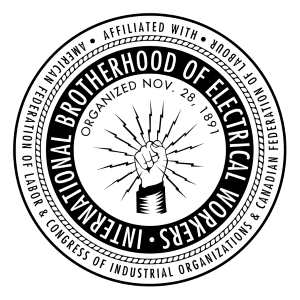History of the IBEW
The International Brotherhood of Electrical Workers (IBEW) is a labor union which represents nearly 750,000 workers and retirees in the electrical industry in the United States, Canada, Panama, Guam and Wake Island. and several Caribbeanisland nations; particularly electricians, or Inside Wiremen, in the construction industry and linemen and other employees of public utilities. The union also represents some workers in the computer, telecommunications, broadcasting, and other fields related to electrical work. It was founded in 1891 shortly after homes and businesses in the United States began receiving electricity. Its international president is Lonnie R. Stephenson. The IBEW is affiliated with the AFL-CIO. The beginnings of the IBEW were in the Electrical Wiremen and Linemen's Union No. 5221, founded in St. Louis, Missouri in 1890. By 1891, after sufficient interest was shown in a national union, a convention was held on November 21, 1891 in St. Louis. At the convention, the IBEW, then known as the National Brotherhood of Electrical Workers (NBEW), was officially formed. The American Federation of Labor gave the NBEW a charter as an AFL affiliate on December 7, 1891. The union's official journal, The Electrical Worker, was first published on January 15, 1893, and has been published ever since. At the 1899 convention in Pittsburgh,Pennsylvania, the union's name was officially changed to the International Brotherhood of Electrical Workers. The union went through lean times in its early years, then struggled through six years of schism during the 1910s, when two rival groups each claimed to be the duly elected leaders of the union. In 1919, as many employers were trying to drive unions out of the workplace through a national open shop campaign, the union agreed to form the Council on Industrial Relations, a bipartite body made up of equal numbers of management and union representatives with the power to resolve any collective bargaining disputes. That body still functions today and has largely eliminated strikes in the IBEW's jurisdiction in the construction industry. In September 1941, the National Apprenticeship Standards for the Electrical Construction Industry, a joint effort among the IBEW, theNational Electrical Contractors Association, and the Federal Committee on Apprenticeship, were established. The IBEW added additional training programs and courses as needed to keep up with new technologies, including an industrial electronics course in 1959 and an industrial nuclear power course in 1966. Today, the IBEW conducts apprenticeship programs for electricians, linemen, and VDV (voice, data, and video) installers (who install low-voltage wiring such as computer networks), in conjunction with the National Electrical Contractors Association, under the auspices of the National Joint Apprenticeship and Training Committee (NJATC), which allows apprentices to "earn while you learn." In Canadian jurisdictions the IBEW does not deliver apprenticeship training, but does conduct supplemental training for government trained apprentices and journeypersons, often at no or little cost to its members. The IBEW local 353 Toronto requires all apprentices to be registered with the JAC (Joint Apprenticeship Council) for a number of safety courses, pre-apprenticeship training, pre trade school coures, supplementary training, as well as pre exam courses.
Page Last Updated: Aug 19, 2015 (06:50:07)
|





